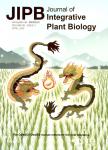Overexpression of micro RNA_(40)8 enhances photosynthesis, growth, and seed yield in diverse plants
Overexpression of micro RNA_(40)8 enhances photosynthesis, growth, and seed yield in diverse plants作者机构:State Key Laboratory of Protein and Plant Gene ResearchPeking-Tsinghua Center for Life SciencesSchool of Life Sciences and School of Advanced Agricultural SciencesPeking University Rice Research InstituteGuangxi Academy of Agricultural Sciences State Key Laboratory of Plant Genomics and National Center for Plant Gene Research(Beijing)Institute of Genetics and Developmental BiologyChinese Academy of Sciences Department of Environmental SciencesUniversity of Virginia
出 版 物:《Journal of Integrative Plant Biology》 (植物学报(英文版))
年 卷 期:2018年第60卷第4期
页 面:323-340页
核心收录:
学科分类:09[农学] 0903[农学-农业资源与环境]
基 金:supported by the National Key Research and Development Program of China (2016YFD0101601)
主 题:and seed yield in diverse plants growth Figure
摘 要:The ability of a plant to produce grain, fruit, or forage depends ultimately on photosynthesis. There have been few attempts, however, to study microRNAs, which are a class of endogenous small RNAs post-transcription- ally programming gene expression, in relation to photosynthetic traits. We focused on miR408, one of the most conserved plant miRNAs, and overexpressed it in parallel in Arabidopsis, tobacco, and rice. The transgenic plants all exhibited increased copper content in the chloroplast, elevated abundance of plastocyanin, and an induction of photosynthetic genes. By means of gas exchange and optical spectroscopy analyses, we showed that higher expression of miR408 leads to enhanced photosynthesis through improving efficiency of irradiation utilization and the capacity for carbon dioxide fixation. Consequently, miR408 hyper-accumulat- ing plants exhibited higher rate of vegetative growth. An enlargement of seed size was also observed in all three species overproducing miR408. Moreover, we conducted a 2-year-two-location field trial and observed miR408 overexpression in rice significantly increased yield, which was primarily attributed to an elevation in grain weight. Taken together, these results demonstrate that miR408 is a positive regulator of photosynthesis and that its genetic engineering is a promising route for enhancing photosynthetic performance and yield in diverse plants.



